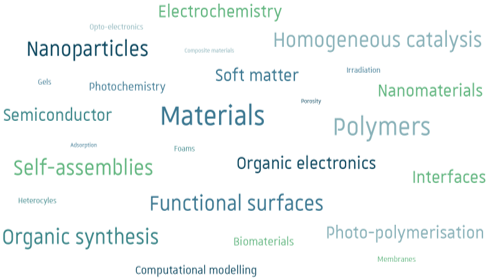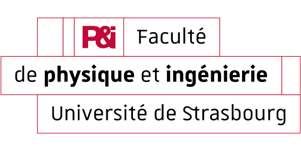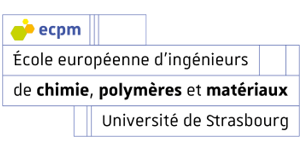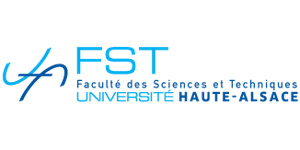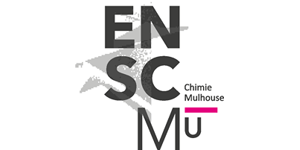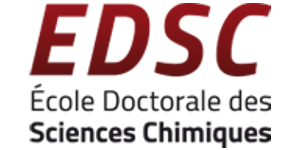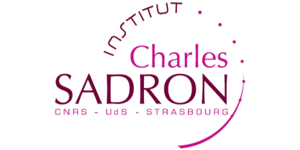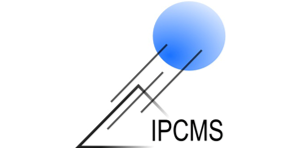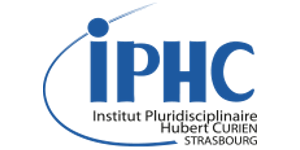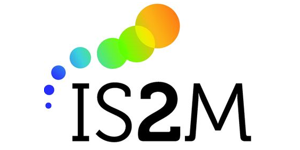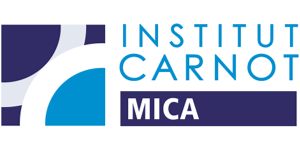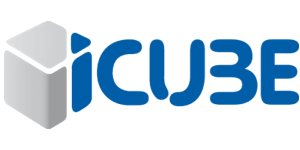ITI HiFunMat is an Excellence cluster formed by a consortium of academic and industrial research facilities, a graduate school, and much more. Discover ITI HiFunMat through four questions: "What is ITI HiFunMat ?", "What are our values", "What are our ambitions?" and "Who are we?"
Page contents
What is ITI HiFunMat?

ITI HiFunMat stands for Interdisciplinary Thematic Institute for Hierarchical and Functional Materials with applications in Health, Environment and Energy.
It is one of the 15 interdisciplinary thematic institutes (ITI) launched by the University of Strasbourg in January 2021 . Their creation is part of the Universities development strategy. They are the continuation of University Research Schools (EUR), and were conceived to contribute to the understanding and resolution of the 21st century's major scientific and societal challenges in science and technology, health and life sciences, social sciences and humanities. As such, they represent a fundamental part in the modernization and improvement of both the Universities research and training landscape.
The interdisciplinary thematic institutes are part of the Initiative of Excellence (IdEx) program. This program is a shared initiative between the University of Strasbourg (UNISTRA), the National center for scientific research (CNRS) and the National institute of health and medical research (Inserm).
Interdisciplinary Thematic Institute for Hierarchical and Functional Materials (ITI HiFunMat) is thus both a cluster of Excellence and a Graduate School.
ITI HiFunMat combines multiple academic research facilities, together with industrial partners, to work at the interfaces between chemistry, physics, nanoscience, and biology to develop and characterize innovative and sustainable composite materials with appealing properties and outstanding applications.
To design such materials and to accomplish state of the art developments in material science, ITI HiFunMat focusses on multi-scale composition control and the spatial arrangement of building blocks. It promotes innovative strategies, such as 3D printing, microfluidics, foams, and multi-step protocols, which are used for the controlled assembly of (multi)functionalized building blocks, such as (macro)molecules and (nano)particles. To go even further in the design of cutting-edge materials, ITI HiFunMat researchers draw inspiration from smart biological systems, capable to process information and react under an external stimulus.
Our values
Our origins
Through scientific exchanges between members of our associated laboratories, the idea and the common need for an ITI based on material science emerged. ITI HiFunMat has thus been conceived and co-constructed by all associated partner laboratories. Our members are continuously involved in the evolution of the ITI, so that it best respond to their needs. It is in our DNA to listen and support our members, their research and their careers. We are open to everyone (regarless their status) and all research domains, laboratories and compagnies interested in material science.
Our values
One of the key values of ITI HiFunMat is 'Inclusion'. We welcome people from all different research domains (Chemistry, Physics, Biology and Material science) and grades (researchers, teachers, engineers, technicians, students). Furthermore, we are attentif to gender equality (recruitement of members, students, in financing projects, ... ). The second key value that describes ITI HiFunMat is 'Support'. We aim to support our members, their research and careers, through financing and mentoring. For example, have set-up mentoring for:
- Newly appointed permanent researcher, by experienced researchers
- Ph.D. students, by young and/or experienced researchers
- Master students, by Ph.D. students and/or researchers
To learn more about our values and what we can do for you, please visit the Mentoring page.
Our ambitions
Hierarchical Functional Materials (HiFunMat) are materials build up from multi-component structures in which the individual components are organized hierarchically in space. They have outstanding functional properties, and often mimic those found in nature. These materials are, for example, able to combine the sensing properties of different molecules to process information and to adapt their properties in response to external stimuli, or even to self-repair. ITI HiFunMat pushes forward the development of the next generation of hierarchical functional materials.
The best way to describe us is by our actions
- ITI HiFunMat operates at the interfaces of multiple research domains, but primarily at the interfaces between chemistry, physics, nanoscience and biology.
- ITI HiFunMat integrates fundamental knowledge from these fields for the development of innovative and sustainable materials and devices with exciting applications.
- ITI HiFunMat develops new composite materials for which the composition and spatial arrangement of the building blocks, as well as their interaction and dynamics, are well controlled at different length scales, both in and out of equilibrium, to achieve remarkable or new properties.
- ITI HiFunMat realises novel fabrication methods, such as 3D printing methods, assemblies via microfluidic systems or assemblies in the form of foams, while controlling interfacial interactions, to direct their positioning at the core or surface of the materials.
- ITI HiFunMat promotes the emergence of new interdisciplinary collaborative projects by providing funding opportunities and supporting young researchers.
- ITI HiFunMat brings together competent partners in academia and industry, while strengthening the link with the socio-economic partners, by participation in the international network of institutes and by being actively involved in national and international outreach.
- ITI HiFunMat strengthens the visibility of research in innovative materials in Alsace on the national and international scope.
- ITI HiFunMat reinforces and develops pedagogical practices based on research and professional skills on the Master and Doctorate degree level.
- ITI HiFunMat encouragesthe involvement of EPST personnel in Master and Doctoral training programs.
Through these actions we hope to fulfill our 2 ambitions
- Train top-level young scientists in material science
ITI HiFunMat would like to meet the strong demand in industry for people with a solid background in material science by offering students a supplementary training to their Master program. This supplementary training adapts to Master programs from different fields of expertise. It focusses on interdisciplinary and most of all, covers cross-cutting high-level scientific courses. Students will familiarize themselves with all the dimensions of innovation and valorization, including both soft and technical skills. We believe this to be essential to meet future social challenges (energy, environment, health).
Learn more about our Graduate School
- Push forward the development of the next generation of materials.
ITI HiFunMat is committed to the design and synthesis of elementary molecular building blocks, the development of new organic synthesis strategies, and the promotion of environmentally friendly processes. We will use these building blocks to develop materials of which the surface characteristics can be finely controlled, to obtain materials with adaptable and reversible properties to their environment. The building blocks, such as (macro)molecules, (nano)particles, drops, etc., are used to develop new 3D materials with hierarchical structures as well. These materials are elaborated by different and innovative processes, such as self-assembly and 3D printing. An important part of this research is the characterization of such structures at different length scales as well as the study of their different properties under general and application conditions. ITI HiFunMat also commits to the development of new strategies for shaping or modifying materials by subjecting them to radiation of various types and energies (photons, electrons, or accelerated ions) to develop original properties. Hence, ITI HiFunMat studies the properties of materials subjected to these radiations, in order to understand the molecular mechanisms at work, or for their integration in optic and electronic devices. Finally, ITI HiFunMat is dedicated to designing new biomimetic, biodegradable, active, self-healing, responsive, life-like material systems, that are able to show original properties and dynamics not observed so far.
Learn more about our research
Who are we?
The excellence cluster ITI HiFunMat is a consortium of 2 universities, 3 faculties, 2 engineering schools and 3 doctoral schools, working together with 9 academic & multiple industrial research institutes in the French Alsace region. ITI HiFunMat promotes cutting edge material science in physics, chemistry and engineering, and strengthens (international) collaborations between the top-players from different research fields.
Involved faculties and Doctoral Schools
ITI HiFunMat is a collaboration between the University of Strasbourg (UNISTRA) and the University de Haute Alsace (UHA). Affiliated to this consortium are the Faculty of Physics and Engineering (l’UFR de Physique et d’Ingénierie), the Faculty of Chemistry (l’UFR de Chimie), the Faculty of Science and Technology (FST), the European engineering school of Chemistry, Polymer and Material Science (ECPM), the National College of Chemical Engineering (ENSCMu), the Doctoral school of physics and Physical-Chemistry (ED PCP), the Doctoral school of chemical science (EDSC), and the Doctoral school of mathematics, information sciences and engineering (ED msii).
Associated research institutes
The associated research institutes are the laboratory of molecular innovation and applications (LIMA, laboratoire d’innovation moléculaire et applications), Institut Charles Sadron (ICS), the institute for chemistry and processes for energy, environment and health (ICPEES, Institut de chimie et procédés pour l’énergie, l’environnement et la santé), the institute of material science of Mulhouse (IS2M, Institut de science des matériaux de Mulhouse), the engineering science, computer science and imaging laboratory (ICube, laboratoire des sciences de l'ingénieur, de l'informatique et de l'imagerie), the laboratory of biomaterials and bioengineering (INSERM UMR 1121, Biomatériaux et bioingénierie), the Hubert Curien multi-disciplinary institute (IPHC, Institut pluridisciplinaire Hubert Curien), the Institute of physical and chemistry materials of Strasbourg (IPCMS, Institut de physique et chimie des matériaux de Strasbourg) and the Laboratory of design and application of bioactive molecules (LCAMB, Laboratoire de conception et application de molécules bioactives).
Industrial partners
ITI HiFunMat’s principal industrial partners are Total, Solvay, URGO, BASF and Institut Carnot Mica. However, in total ITI HiFunMat counts 75 industrial partners.


